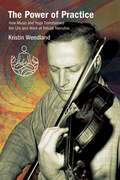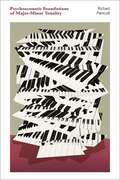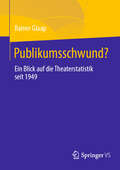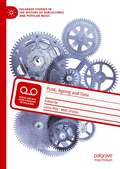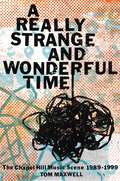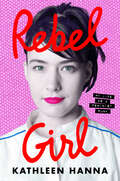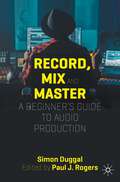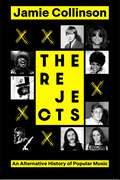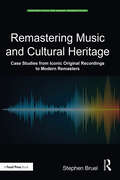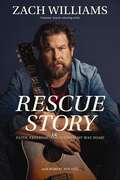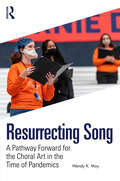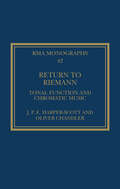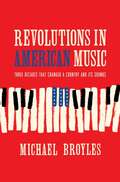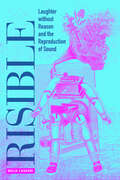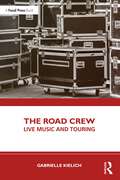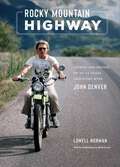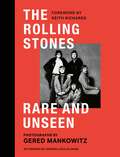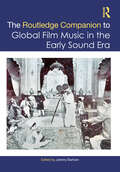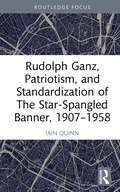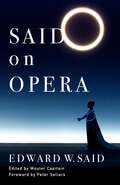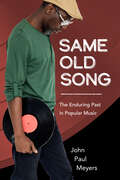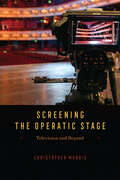- Table View
- List View
The Power of Practice: How Music and Yoga Transformed the Life and Work of Yehudi Menuhin (SUNY Press Open Access)
by Kristin WendlandThe Power of Practice showcases the pioneering achievements of renowned violinist Yehudi Menuhin (1916-99) and how both disciplines transformed his life and practice. Menuhin's contributions as a performer, teacher, and humanitarian are celebrated around the world. Less well known, however, is Menuhin's devotion to the practice of yoga and his close friendship with the renowned yogi B. K. S. Iyengar (1918–2014), whose guidance profoundly influenced Menuhin as both a musician and a philanthropist. Menuhin applied his understanding of Iyengar's teachings to his philosophy of musical practice, creating new ways to approach the teaching of violin technique. He also took broader lessons from yoga to inform his approach to interacting with the larger world as a cultural ambassador and influential artist. Through the lens of the life and work of the celebrated violinist and devoted yogi, this book uncovers deep connections between music and yoga. It shows how the practice of both disciplines can profoundly transform our world into a better place.
Psychoacoustic Foundations of Major-Minor Tonality
by Richard ParncuttA fascinating interdisciplinary approach to how everyday Western music works, and why the tones, melodies, and chords combine as they do.Despite the cultural diversity of our globalized world, most Western music is still structured around major and minor scales and chords. Countless thinkers and scientists of the past have struggled to explain the nature and origin of musical structures. In Psychoacoustic Foundations of Major-Minor Tonality, music psychologist Richard Parncutt offers a fresh take, combining music theory—Rameau&’s fundamental bass, Riemann&’s harmonic function, Schenker&’s hierarchic analysis, Forte&’s pitch-class set theory—with psychology—Bregman&’s auditory scene, Terhardt&’s virtual pitch, Krumhansl&’s tonal hierarchy. Drawing on statistical analyses of notated music corpora, Parncutt charts a middle path between cultural relativism and scientific positivism to bring music theory into meaningful discourse with empirical research.Our musical subjectivity, Parncutt explains, depends on our past musical experience and hence on music history and its social contexts. It also depends on physical sound properties, as investigated in psychoacoustics with auditory experiments and mathematical models. Parncutt&’s evidence-based theory of major-minor tonality draws on his interdisciplinary background to present a theory that is comprehensive, creative, and critical. Examining concepts of interval, consonance, chord root, leading tone, harmonic progression, and modulation, he asks:Why are some scale tones and chord progressions more common than others?What aspects of major-minor tonality are based on human biology or general perceptual principles? What aspects are culturally arbitrary? And what about colonial history?Original and provocative, Psychoacoustic Foundations of Major-Minor Tonality promises to become a foundational text in both music theory and music cognition.
Publikumsschwund?: Ein Blick auf die Theaterstatistik seit 1949
by Rainer GlaapDurch den teils massiven Publikumsschwund nach der Pandemie stellt sich die Frage, ob diese als Brandbeschleuniger gewirkt hat für bereits vorhandene Trends. Der Autor geht dem nach anhand der Besuchszahlen bis zur letzten vollständigen vorpandemischen Spielzeit 2018/19. Er zeigt historische Zeitreihen zu Sparten- und Personalentwicklung, Vertriebskanälen und den Einnahmen. Die Theaterstatistik des Bühnenvereins dient vielen Entscheidungsträgern als Grundlage für z.B. kulturpolitische Steuerungen, obwohl sie nicht die komplette deutsche Theaterlandschaft abbildet. Deshalb beleuchtet der Autor weitere Anbieter. Da die Theaterstatistik große kulturpolitische Bedeutung hat, gibt es zum Schluss einige Vorschläge für die Zukunft.
Punk, Ageing and Time (Palgrave Studies in the History of Subcultures and Popular Music)
by Laura Way Matt GrimesTo date there has been no plotting of punk scholarship which speaks to ‘time’, yet there are some clear bodies of work pertaining to particular issues relevant to it, including ageing and/or the life course and punk, memory and/or nostalgia and punk, ‘punk history’, and archiving and punk. Punk, Ageing and Time is therefore a timely (pun intended) book. What this edited collection does for the first time is bring together contemporary investigations and discussions specifically around punk and ageing and/or time, covering areas such as: punk and ageing; the relationship between temporality and particular concepts relevant to punk (such as authenticity, DIY, identity, resistance, spatiality, style); and punk memory, remembering and/or forgetting. Multidisciplinary in nature, this book considers areas which have received very little to no academic attention previously.
A Really Strange and Wonderful Time: The Chapel Hill Music Scene: 1989-1999
by Tom MaxwellTHE FIRST BIOGRAPHY OF THE THRIVING AND INFLUENTIAL ROCK SCENE IN CHAPEL HILL, WHICH GAVE THE WORLD ARTISTS LIKE BEN FOLDS FIVE, SUPERCHUNK, AND SQUIRREL NUT ZIPPERS North Carolina has always produced extraordinary music of every description. But the indie rock boom of the late 1980s and early &’90s brought the state most fully into the public consciousness, while the subsequent post-grunge free-for-all bestowed its greatest commercial successes. In addition to the creation of legacy label Merge Records and a slate of excellent indie bands like Superchunk, Archers of Loaf, and Polvo, this was the decade when other North Carolina artists broke Billboard &’s Top 200 and sold millions of records—several million of which were issued by another indie label based in Carrboro, Chapel Hill&’s smaller next-door neighbor. It&’s time to take a closer look at exactly what happened.A Really Strange and Wonderful Time features a representative cross section of what was being created in and around Chapel Hill between 1989 and 1999. In addition to the aforementioned indie bands, it documents—through firsthand accounts—other local notables like Ben Folds Five, Dillon Fence, Flat Duo Jets, Small, Southern Culture on the Skids, The Veldt, and Whiskeytown. At the same time, it describes the nurturing infrastructure which engendered and encouraged this marvelous diversity. In essence, A Really Strange and Wonderful Time is proof of the genius of community.
Rebel Girl: My Life as a Feminist Punk
by Kathleen HannaAn electric, searing memoir by the original rebel girl and legendary front woman of Bikini Kill and Le Tigre.Hey girlfriend I got a proposition goes something like this: Dare ya to do what you want Kathleen Hanna’s band Bikini Kill embodied the punk scene of the 90s, and today her personal yet feminist lyrics on anthems like “Rebel Girl” and “Double Dare Ya” are more powerful than ever. But where did this transformative voice come from?In Rebel Girl, Hanna’s raw and insightful new memoir, she takes us from her tumultuous childhood to her formative college years and her first shows. As Hanna makes clear, being in a punk “girl band” in those years was not a simple or safe prospect. Male violence and antagonism threatened at every turn, and surviving as a singer who was a lightning rod for controversy took limitless amounts of determination.But the relationships she developed during those years buoyed her, including with her bandmates Tobi Vail, Kathi Wilcox, JD Samson, and Johanna Fateman. And her friendships with musicians like Kurt Cobain, Ian MacKaye, Kim Gordon, and Joan Jett reminded her that, despite the odds, the punk world could still nurture and care for its own. Hanna opens up about falling in love with Ad-Rock of the Beastie Boys and her debilitating battle with Lyme disease, and she brings us behind the scenes of her musical growth in her bands Le Tigre and The Julie Ruin. She also writes candidly about the Riot Grrrl movement, documenting with love its grassroots origins but critiquing its exclusivity.In an uncut voice all her own, Hanna reveals the hardest times along with the most joyful—and how they continue to fuel her revolutionary art and music.
Record, Mix and Master: A Beginner’s Guide to Audio Production
by Simon DuggalThis textbook is a practical guide to achieving professional-level audio productions using digital audio workstations. It contains 27 chapters divided into three sections, with specially devised diagrams and audio examples throughout. Aimed at students of all levels of experience and written in an easy-to-understand way, this book simplifies complex jargon, widening its appeal to non-academic creatives and is designed to accelerate the learning of professional audio processes and tools (software and hardware).The reader can work through the book from beginning to end or dip into a relevant section whenever required, enabling it to serve as both a step by step guide and an ongoing reference manual. The book is also a useful aid for lecturers and teachers of audio production, recording, mixing and mastering engineering.
The Rejects: An Alternative History of Popular Music
by Jamie CollinsonImagine you've made it. You and your friends have hit the big time in music and you're going to be a star. But then, quite suddenly, it's over. Your best friends don't want you anymore, and you're on the outside. Perhaps they're tired of your bad habits, they think you're not good enough, or they sense you just don't want it as much as they do. Whatever the cause, you're a reject. So, what do you do next?Featuring a player rejected by both Nirvana and Soundgarden who became a decorated special forces soldier, Britpoppers who spiralled into addiction before becoming novelists and missionaries, the terrifying story of Guns N' Roses' first drummer, super-rejecting band leaders, self-destroying rappers, troubled hard rock bassists and girl-band burnouts, The Rejects takes an intimate, thoughtful look at people who've been kicked out of bands, what they experienced and what came afterwards.Coming from a writer with twenty years' music industry experience, The Rejects is a sympathetic study of some of music's most fascinating characters, and what happens when the dream comes crashing to an end. The result is a compelling alternative history of popular music.
The Rejects: An Alternative History of Popular Music
by Jamie CollinsonImagine you've made it. You and your friends have hit the big time in music and you're going to be a star. But then, quite suddenly, it's over. Your best friends don't want you anymore, and you're on the outside. Perhaps they're tired of your bad habits, they think you're not good enough, or they sense you just don't want it as much as they do. Whatever the cause, you're a reject. So, what do you do next?Featuring a player rejected by both Nirvana and Soundgarden who became a decorated special forces soldier, Britpoppers who spiralled into addiction before becoming novelists and missionaries, the terrifying story of Guns N' Roses' first drummer, super-rejecting band leaders, self-destroying rappers, troubled hard rock bassists and girl-band burnouts, The Rejects takes an intimate, thoughtful look at people who've been kicked out of bands, what they experienced and what came afterwards.Coming from a writer with twenty years' music industry experience, The Rejects is a sympathetic study of some of music's most fascinating characters, and what happens when the dream comes crashing to an end. The result is a compelling alternative history of popular music.
Remastering Music and Cultural Heritage: Case Studies from Iconic Original Recordings to Modern Remasters (Perspectives on Music Production)
by Stephen BruelRemastering Music and Cultural Heritage presents a detailed account of the culture and practice of remastering music recordings. By investigating the production processes and the social, nostalgic and technological components of remastering practice, the book demonstrates the application of these techniques to iconic recordings by artists including The Beatles, Elton John and Oasis. Through comprehensive interviews with music production professionals directly involved in both the original productions and remastered releases of these iconic recordings – and detailed digital audio analysis – this book offers an extensive insight into music production and remastering practice. Readers learn about the music production techniques behind creating some of the most well-recognised and loved albums of all time, as well as the processes used to create the remasters, to help guide their own projects. Remastering Music and Cultural Heritage is essential reading for students and teachers of music production, professional practitioners and musicians.
Rescue Story: Faith, Freedom, and Finding My Way Home
by Zach WilliamsFrom a hard-rocking life fueled by substance abuse to a hope-filled life of freedom and joy--this is music star Zach Williams's bold and vulnerable story of faith and redemption.Before two-time GRAMMY Award winner Zach Williams penned heartfelt, faith-filled ballads like "Chain Breaker," "There Was Jesus (featuring Dolly Parton)," and "Fear Is a Liar," there was darkness. A rock-and-roll singer who thought he had all he ever wanted to make him happy, Zach instead felt empty. The drugs, alcohol, and late-night gigs played around the world couldn't satisfy the longing in his heart for a place to belong. He was desperate for change.It came while on tour in Spain with his band, and in this powerful and poignant memoir, Zach shares in vivid detail his personal Rescue Story. He reflects on his childhood and the prophecy that kept his parents from giving up hope, his descent into the substance abuse that held him captive for so long, and ultimately the rescue he didn't think was possible but embraced with open arms.A compelling, honest story of God's unconditional love, grace, and redemption, Rescue Story shares the intimate journey of a beloved music artist and challenges you to seek resilient hope in the trials of your own life--because Jesus offers real freedom and joy, despite the mistakes of your past.
Resurrecting Song: A Pathway Forward for the Choral Art in the Time of Pandemics
by Wendy K. MoyThrough a collection of extensive interviews with choral conductors, educators, singers, and professional leaders, this book documents the choral music community’s journey through crisis and change during the COVID-19 pandemic and aids in its rebuilding in a new era where COVID-19 is endemic.When the pandemic emerged in early 2020, the impact on choral music was immediate and devastating, as the act of gathering and singing together became a source of contagion and potential severe illness or death. Weaving together a wide range of first-person accounts, this book addresses the impact of the coronavirus pandemic on choral music across contexts including community choruses, professional choirs, children and youth choirs, school choirs, and choral organizations. In their own words, we hear how the community responded to the challenges and banded together to innovate, use technology in new ways, and generate changes to practice. The book also explores how the pandemic caused many directors to realize that they needed to create a more inclusive place of belonging in their rehearsals, and provides reflections on the philosophy of singing and creating a choral community.Documenting both pandemic experiences and the lessons learned from surviving and thriving, this book showcases the resilience of choral music and helps point the way to new directions for the choral community in the wake of the pandemic.
Return to Riemann: Tonal Function and Chromatic Music (ISSN)
by J. P. Harper-Scott Oliver ChandlerThis book is a music-theoretical and critical-theoretical study of late tonal music, and, in particular, of the music of Wagner’s Götterdämmerung.First, in terms of music theory, it proposes a new theory of tonal function that returns to the theories of Hugo Riemann to rediscover a development of his thought that has been covered over by the recent project of neo-Riemannian theory. Second, in terms of its philosophical approach, it reawakens the critical-theoretical examination of the relation between music and the late capitalist society that is sedimented in the musical materials themselves, and which the music, in turn, subjects to aesthetically embodied critique. The music, the theory, and the listeners and critics who respond to them are all radically reimagined.This book will be of interest to professional music theorists, undergraduates, and technically inclined musicians and listeners, that is, anyone who is fascinated by the chromatic magic of late-nineteenth-century music.
Revolutions in American Music: Three Decades That Changed a Country and Its Sounds
by Michael BroylesThe story of how unexpected connections between music, technology, and race across three tumultuous decades changed American culture. How did a European social dance craze become part of an American presidential election? Why did the recording industry become racially divided? Where did rock ’n’ roll really come from? And how do all these things continue to reverberate in today’s world? In Revolutions in American Music, award-winning author Michael Broyles shows the surprising ways in which three key decades—the 1840s, the 1920s, and the 1950s—shaped America’s musical future. Drawing connections between new styles of music like the minstrel show, jazz, and rock ’n’ roll, and emerging technologies like the locomotive, the first music recordings, and the transistor radio, Broyles argues that these decades fundamentally remade our cultural landscape in enduring ways. At the same time, these connections revealed racial fault lines running through the business of music, in an echo of American society as a whole. Through the music of each decade, we come to see anew the social, cultural, and political fabric of the time. Broyles combines broad historical perspective with an eye for the telling detail and presents a variety of characters to serve as focal points, including the original Jim Crow, a colorful Hungarian dancing master named Gabriel de Korponay, “Empress of the Blues” Bessie Smith, and the singer Johnnie Ray, whom Tony Bennett called “the father of rock ’n’ roll.” Their stories, and many others, animate Broyles’s masterly account of how American music became what it is today.
Risible: Laughter without Reason and the Reproduction of Sound
by Delia CasadeiA free ebook version of this title is available through Luminos, University of California Press’s Open Access publishing program. Visit www.luminosoa.org to learn more.Risible explores the forgotten history of laughter, from ancient Greece to the sitcom stages of Hollywood. Delia Casadei approaches laughter not as a phenomenon that can be accounted for by studies of humor and theories of comedy but rather as a technique of the human body, knowable by its repetitive, clipped, and proliferating sound and its enduring links to the capacity for language and reproduction. This buried genealogy of laughter re-emerges with explosive force thanks to the binding of laughter to sound reproduction technology in the late nineteenth century. Analyzing case studies ranging from the early global market for phonographic laughing songs to the McCarthy-era rise of prerecorded laugh tracks, Casadei convincingly demonstrates how laughter was central to the twentieth century’s development of the very category of sound as not-quite-human, unintelligible, reproductive, reproducible, and contagious.
The Road Crew: Live Music and Touring
by Gabrielle KielichThe Road Crew: Live Music and Touring is an in-depth study of the road crew – the group of workers who handle the logistical and technical requirements of popular music concert tours – that provides an extensive look at the activities and personnel involved in the daily operation of these events. Using interviews with road crew members, participant observation at concert venues and archival research, this book covers a range of topics, including how they learn their roles and maintain work through networks and informal practices, the experience of being on tour and the workplace culture of road crews, the daily tasks and necessary documents that contribute to the realisation of concert events, and the integral role that tour managers play in the working lives of musicians. The book also provides important insights into the experience of women working in a male-dominated field, the ways in which hierarchy shapes the working lives of “support” workers and the effects of touring on road crew members. The Road Crew will be of interest to scholars and students of popular music, live music and the creative industries, as well as music fans, journalists, and professionals and practitioners in the music industries.
The Road Crew: Live Music and Touring
by Gabrielle KielichThe Road Crew: Live Music and Touring is an in-depth study of the road crew – the group of workers who handle the logistical and technical requirements of popular music concert tours – that provides an extensive look at the activities and personnel involved in the daily operation of these events.Using interviews with road crew members, participant observation at concert venues and archival research, this book covers a range of topics, including how they learn their roles and maintain work through networks and informal practices, the experience of being on tour and the workplace culture of road crews, the daily tasks and necessary documents that contribute to the realisation of concert events, and the integral role that tour managers play in the working lives of musicians. The book also provides important insights into the experience of women working in a male-dominated field, the ways in which hierarchy shapes the working lives of “support” workers and the effects of touring on road crew members.The Road Crew will be of interest to scholars and students of popular music, live music and the creative industries, as well as music fans, journalists, and professionals and practitioners in the music industries.
Rocky Mountain Highway: Stories and Photos of My 25 Years Traveling with John Denver
by Lowell NormanA powerful personal journey with multi-platinum country star John Denver, featuring intimate stories and never-before-seen photographs. This memoir from Lowell Norman, a close friend and videographer of the late star, offers a rare and fascinating look inside Denver&’s successful but turbulent life.The award-winning country star, John Denver was once described as a complicated man who wrote simple songs. In Rocky Mountain Highway, close friend and videographer, Lowell Norman reveals rare stories and never-before-seen photos of a John Denver that is at turns familiar and shockingly unexpected. He recounts the emotional live performances and the challenges of shooting such a big star. He describes in harrowing detail the frightening experience of being harassed by gun wielding soldiers with Denver on his tours of Africa for The Hunger Project. He tells the riveting story of dangling from a helicopter with a video camera while the intrepid singer tried to swim with humpback whales in the Pacific Ocean. Rocky Mountain Highway is a celebration of a young man following the dreams of a talented artist who was misunderstood by many and gone before his time.
The Rolling Stones Rare and Unseen: Foreword by Keith Richards, afterword by Andrew Loog Oldham
by Gered MankowitzFOREWORD BY KEITH RICHARDS'ICONIC... DAZZLING.'-MOJO'Gered was at one with the band. More than that, for that special time, he was in the band.'-ANDREW LOOG OLDHAM'He was a hell of a lot of fun. That's why he was a good photographer.'-MARIANNE FAITHFULLDelve into the unseen archive of iconic photographer Gered Mankowitz as he shares rare and newly discovered images of his time with the Rolling Stones, alongside his most iconic shots.Just a teenager, Mankowitz took some of the best-loved photographs of the Stones in their frantic, formative years. Now for the first time he looks beyond those famous images - unearthing frames that have never been seen before, plus those rarely used.Also featuring Gered's first-hand stories and a host of expert writers on the band and their music - including The Times' chief rock and pop critic Will Hodgkinson, Ben Sisario of the New York Times as well as academics, fashion writers and more - The Rolling Stones Rare and Unseen is a fresh look at the greatest story in rock 'n' roll.AFTERWORD BY ANDREW LOOG OLDHAM
The Rolling Stones Rare and Unseen: Foreword by Keith Richards, afterword by Andrew Loog Oldham
by Gered MankowitzFOREWORD BY KEITH RICHARDS'ICONIC... DAZZLING.'-MOJO'Gered was at one with the band. More than that, for that special time, he was in the band.'-ANDREW LOOG OLDHAM'He was a hell of a lot of fun. That's why he was a good photographer.'-MARIANNE FAITHFULLDelve into the unseen archive of iconic photographer Gered Mankowitz as he shares rare and newly discovered images of his time with the Rolling Stones, alongside his most iconic shots.Just a teenager, Mankowitz took some of the best-loved photographs of the Stones in their frantic, formative years. Now for the first time he looks beyond those famous images - unearthing frames that have never been seen before, plus those rarely used.Also featuring Gered's first-hand stories and a host of expert writers on the band and their music - including The Times' chief rock and pop critic Will Hodgkinson, Ben Sisario of the New York Times as well as academics, fashion writers and more - The Rolling Stones Rare and Unseen is a fresh look at the greatest story in rock 'n' roll.AFTERWORD BY ANDREW LOOG OLDHAM
The Routledge Companion to Global Film Music in the Early Sound Era (Routledge Music Companions)
by Jeremy BarhamIn a major expansion of the conversation on music and film history, The Routledge Companion to Global Film Music in the Early Sound Era draws together a wide-ranging collection of scholarship on music in global cinema during the transition from silent to sound films (the late 1920s to the 1940s). Moving beyond the traditional focus on Hollywood, this Companion considers the vast range of cinema and music created in often-overlooked regions throughout the rest of the world, providing crucial global context to film music history. An extensive editorial Introduction and 50 chapters from an array of international experts connect the music and sound of these films to regional and transnational issues—culturally, historically, and aesthetically—across five parts: Western Europe and Scandinavia Central and Eastern Europe North Africa, The Middle East, Asia, and Australasia Latin America Soviet Russia Filling a major gap in the literature, The Routledge Companion to Global Film Music in the Early Sound Era offers an essential reference for scholars of music, film studies, and cultural history.
Rudolph Ganz, Patriotism, and Standardization of The Star-Spangled Banner, 1907-1958
by Iain QuinnThis book examines the succession of events toward the potential standardization of the music for “The Star-Spangled Banner” from an initial letter to President Roosevelt in 1907 to the 1958 congressional hearings on the National Anthem, and the later work of the Swiss-Born American pianist, Rudolph Ganz. These events took place across five decades when a culture of public patriotism was especially pronounced for immigrant musicians. This book contextualizes the complementary experiences of a leading immigrant musician, Ganz, who successfully navigated the world of public patriotism while pursuing the realization of a standardized version. The materials are discussed through the lens of the performance practice. The legacy of standardization has not previously been examined. The response and actions of an immigrant, Ganz, in a culture of necessary patriotism for foreign-born artists shed important new light on this topic. It demonstrates the challenges, fears, and cultural expectations regarding the standardization of an important patriotic work.
Said on Opera
by Edward SaidOne of the late twentieth century’s most celebrated and influential public intellectuals, Edward W. Said was also a critic of astonishing range. This book presents his insightful and elegant analyses of four major operas—originally delivered as the Empson Lectures at Cambridge University in 1997—showcasing the power of Said’s critical acumen to unsettle canonical interpretations.In close readings of Mozart’s Così fan tutte, Beethoven’s Fidelio, Berlioz’s Les Troyens, and Wagner’s Die Meistersinger von Nürnberg, Said explores how each opera engages with the social and political questions of their own eras—and how they might speak to the present. He pays careful attention to the works’ historical context as well as the possibilities they open for contemporary reinterpretations, examining the tension between opera’s cultural prestige and its potential for subversion. Said considers the representation of national identity, class, and exoticism, and he shows how cultural and literary studies can enrich understandings of operatic texts and performance. Lucid and gracefully written, Said on Opera enlivens well-known works with fresh insights and demonstrates the breadth of Said’s contributions to cultural criticism.This book features an introduction by the editor, Wouter Capitain, who situates these essays in the context of Said’s career, and a foreword by the acclaimed opera director Peter Sellars, who offers a masterful appreciation of Said’s achievements.
Same Old Song: The Enduring Past in Popular Music (American Made Music Series)
by John Paul MeyersPopular music and its listeners are strongly associated with newness and youth. Young people can stay up late dancing to the latest hits and use cutting-edge technology for listening to and sharing fresh music. Many young people incorporate their devotion to new artists and styles into their own developing personalities. However, if popular music is a genre meant for the youthful, what are listeners to make of the widespread sampling of music from decades-old R&B tracks, sold-out anniversary tours by aging musicians, retrospective box sets of vintage recordings, museum exhibits, and performances by current pop stars invoking music and images of the past? In Same Old Song: The Enduring Past in Popular Music, John Paul Meyers argues that these phenomena are part of what he calls “historical consciousness in popular music.” These deep relationships with the past are an important but underexamined aspect of how musicians and listeners engage with this key cultural form. In chapters ranging across the landscape of twentieth- and twenty-first-century music, Meyers finds indications of historical consciousness at work in multiple genres. Rock music canonizes its history in tribute performances and museums. Jazz and pop musicians cover tunes from the “Great American Songbook.” Hip-hop and contemporary R&B singers invoke Black popular music from the 1960s and 1970s. Examining the work of influential artists like Ella Fitzgerald, Bob Dylan, Miles Davis, Kanye West, Prince, D’Angelo, and Janelle Monáe, Meyers argues that contemporary artists’ homage to the past is key for understanding how music-lovers make meaning of popular music in the present.
Screening the Operatic Stage: Television and Beyond (Opera Lab: Explorations in History, Technology, and Performance)
by Christopher MorrisAn ambitious study of the ways opera has sought to ensure its popularity by keeping pace with changes in media technology. From the early days of television broadcasts to today’s live streams, opera houses have embraced technology as a way to reach new audiences. But how do these new forms of remediated opera extend, amplify, or undermine production values, and what does the audience gain or lose in the process? In Screening the Operatic Stage, Christopher Morris critically examines the cultural implications of opera’s engagement with screen media. Foregrounding the potential for a playful exchange and self-awareness between stage and screen, Morris uses the conceptual tools of media theory to understand the historical and contemporary screen cultures that have transmitted the opera house into living rooms, onto desktops and portable devices, and across networks of movie theaters. If these screen cultures reveal how inherently “technological” opera is as a medium, they also highlight a deep suspicion among opera producers and audiences toward the intervention of media technology. Ultimately, Screening the Operatic Stage shows how the conventions of televisual representation employed in opera have masked the mediating effects of technology in the name of fidelity to live performance.
